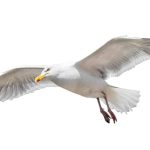Exploring the Fascinating World of the African Jacana: Unveiled Secrets of this Unique Species
African Jacana Facts
Prey Insects, crustaceans Name Of Young Chicks Group Behavior
- Social
Fun Fact The males care for the young Estimated Population Size one million Biggest Threatloss of habitat Most Distinctive Feature Large feet and long toesWingspan20 inches Incubation Period 26 daysAge Of Independence70 days Age Of Fledgling35 days
Habitat Freshwater lakes Diet Carnivore Lifestyle
- Diurnal
Favorite Food Insects Type Bird Common Name African jacana Number Of Species2 Location Sub-Saharan Africa Average Clutch Size4Nesting Location Floating vegetation
African Jacana Physical Characteristics
- Color
-
- Brown
- Yellow
- Blue
- Black
- White
- Skin Type
- Feathers
- Lifespan
- 5 to 10 years
- Weight
- 4 to 12 ounces
- Length
- 9 to 12 inches
“They possess enormous feet with elongated toes.”
The African jacana stands out as one of the most intriguing and distinctive birds across the globe. Their remarkable toes, unique parenting methods, and peculiar vocalizations make them a fascinating species to observe. Discover all there is to know about this African bird, including its habitat, parenting techniques, and feeding habits.
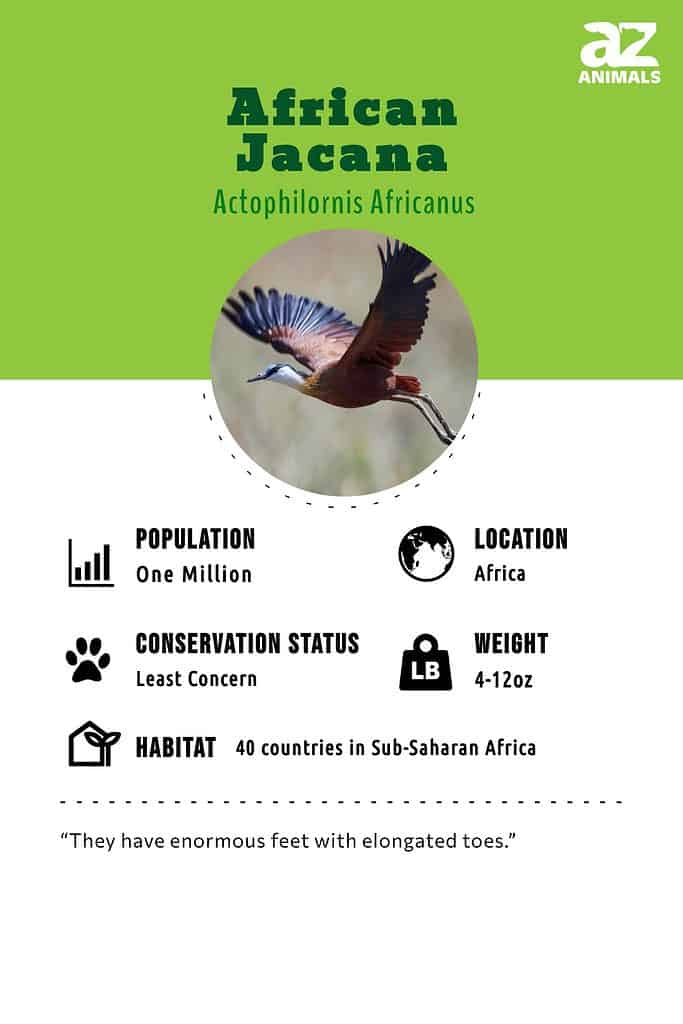
5 Amazing African Jacana Facts
- The African jacana emits calls that resemble shrieks, groans, and barks.
- The male tends to the young and shelters them under his wings.
- They possess vast feet that enable them to walk on floating foliage.
- They are proficient swimmers and divers, though not particularly strong fliers.
- Chicks acquire the ability to dive to evade threats from predators.
Where to Find the African Jacana
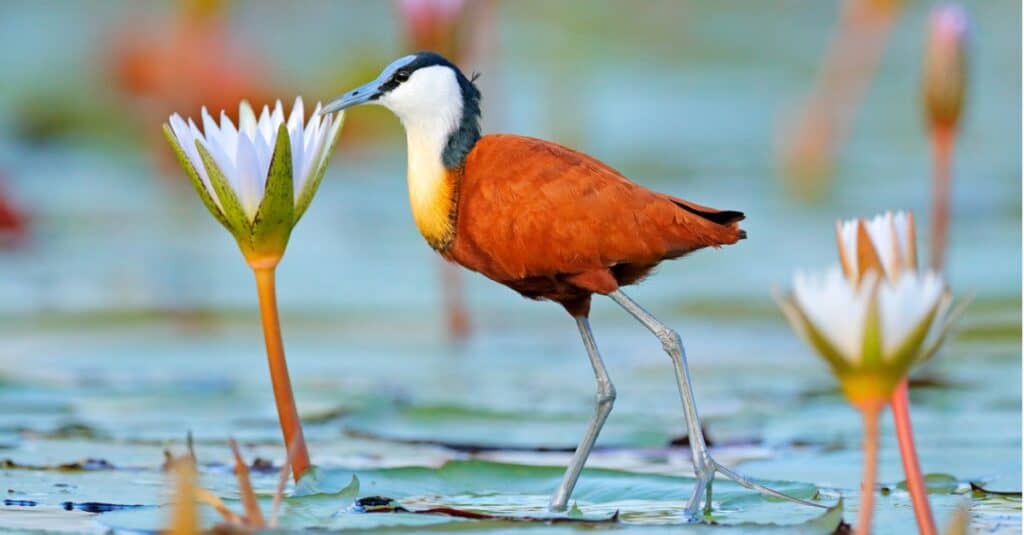
©Ondrej Prosicky/Shutterstock.com
The African jacana can be found across more than 40 nations in Sub-Saharan Africa, spanning from Mauritania through Sudan down to the southernmost part of South Africa. Countries such as Ghana, Ethiopia, Zambia, Tanzania, and Togo host these birds. They are prevalent in the continent’s freshwater wetlands but are absent from forests, jungles, deserts, or savannas. Search for them in shallow lakes teeming with floating plants. Although they do not migrate, they exhibit a degree of nomadism, relocating during fluctuations in water levels due to flooding or drought, in pursuit of lily pad-covered areas where males typically establish their nests. The African jacana might be among the most recognizable birds due to its distinct feet and ability to traverse water.
Jacana Nest
Their nests are uncomplicated structures formed from floating mats comprised of lily pads or other aquatic plants. These typically rest partially submerged in deeper sections of a lake, often under the cover of shady trees or other vegetation.
Scientific Name
The African jacana is scientifically classified as Actophilornis Africanus. It belongs to the order Charadriiformes, which encompasses aquatic birds like auks, gulls, and waders. The family Jacanidae, often referred to as “Jesus birds” or “lily trotters,” contains tropical waders characterized by their elongated toes. The genus Actophilornis consists of the African jacana and the rare Madagascar jacana.
Size, Appearance, and Behavior
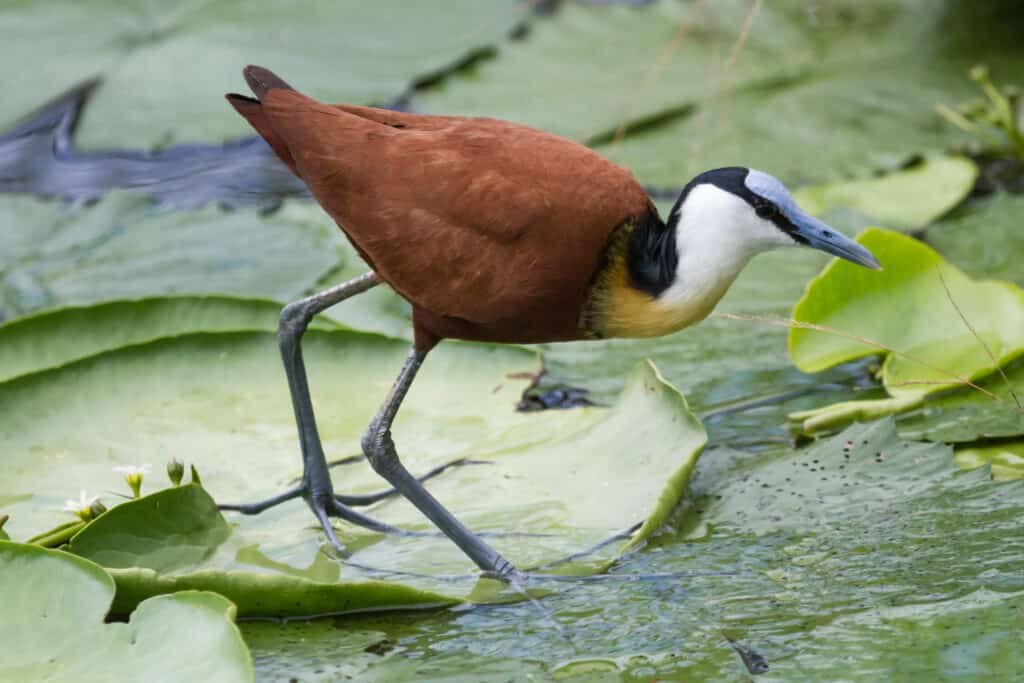
©Kelly Ermis/Shutterstock.com
Adult African jacanas are medium-sized waterbirds distinguished by their long necks, legs, and short tails. Their large feet are their most distinguishing trait, equipped with elongated toes that facilitate movement on floating flora. They range in length from nine to twelve inches, with females generally being slightly larger. Their weight falls between four and twelve ounces, with wingspans reaching up to 20 inches. These jacanas are predominantly reddish-brown, accented with a yellow breast. Their head and neck display a black rear and a white front, accompanied by short blue bills and black eye stripes.
This species is quite vocal, generating loud shrieks, moans, and barks. Their vocal expressions include flight calls and sharp alarm signals. In contrast to many bird species, it is the males that construct the nests, incubate the eggs, and raise the chicks. The fathers are extremely protective, often cradling their young under their wings. Besides walking on water, jacanas are skilled swimmers and divers, with males training their chicks to dive early on to escape threats. Although capable of flying, they lack strength for extensive flight and can only manage short distances. Furthermore, their feathers undergo simultaneous molting, leaving them flightless until regrowth.
Evolution
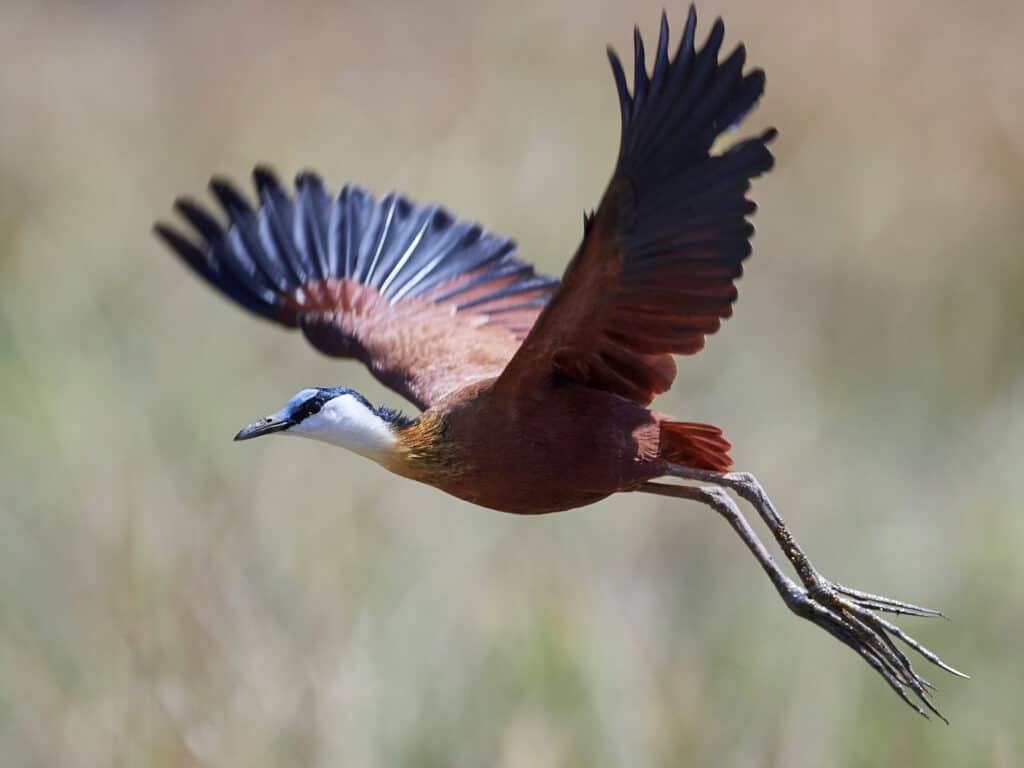
©Dennis Jacobsen/Shutterstock.com
The African jacana is categorized under the genus Actophilornis, part of seven within the Jacanidae family. The Madagascar jacana (Actophilornis albinucha) also belongs to this genus. Other genera comprise: Madags
- Jacana: This includes the northern jacana (jacana spinosa) and the wattled jacana (jacana jacana).
- Hydrophasianus: This genus includes the pheasant-tailed jacana (Hydrophasianus chirurgus). It is unique among jacana species as it has six neck vertebrae, whereas the others have five.
- Irediparra: This includes the comb-crested jacana (Irediparra gallinacea).
- Metopidius: This consists of the bronze-winged jacana (Metopidius indicus).
- Microparra: This contains the lesser jacana (Microparra capensis).
Fossils revealing the unique gender roles in parenting and mating behaviors have been discovered in Africa and the Americas. The oldest fossil dates back to the Oligocene era, approximately 23 to 34 million years ago. A more recent find from the Pliocene, dating back 2.59 to 5.33 million years, was unearthed in Florida.
Diet
African jacanas are carnivorous and have a diverse diet.
What Does the African Jacana Eat?
These distinctive birds consume freshwater insects, larvae, spiders, crustaceans, and mollusks. They forage for food by walking on lily pads and other floating plants. While they can swim and fly, they prefer walking on water, occasionally reaching out to capture flying insects. They are also seen collecting bugs from the backs of buffalo and hippos.
Predators, Threats, and Conservation Status
The IUCN classifies the African jacana as “least concern” due to its wide distribution and stable numbers. Nonetheless, the species faces threats, particularly regarding its eggs. Although abundant, it struggles with habitat destruction, flooding, wetland drainage, and overgrazing by other wildlife. An invasive species, nutria, poses a risk by damaging water lily habitats essential for jacanas. Fortunately, they can utilize alternative floating vegetation for nesting.
What Eats the African Jacana?

©iStock.com/Artush
The eggs and chicks of the African jacana are particularly vulnerable to several predators, including birds of prey, otters, crocodiles, large fish, and turtles. Additionally, threats come from the Nile monitor, hippopotamus, and snakes, which feed on eggs and young birds found in the water.
Reproduction, Young, and Molting
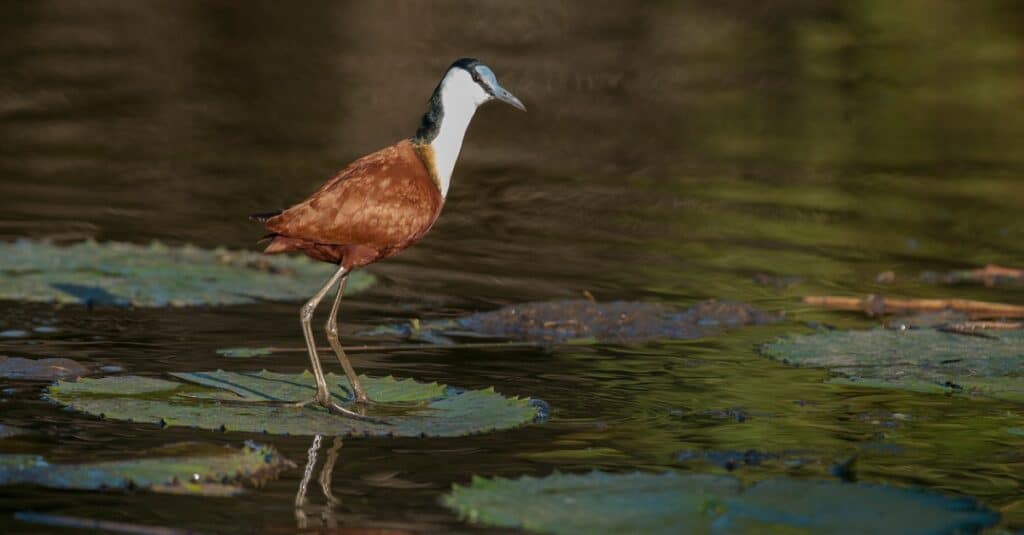
©iStock.com/Foto4440
African jacanas are capable of breeding year-round, except in areas with a dry season, during which they breed seasonally. Their breeding system is polyandrous, where the female abandons the nest shortly after laying eggs. She then seeks a new mate, leaving the males to tend to the young. The males construct semi-submerged floating nests, where the female deposits four eggs. Once she departs, he incubates the eggs for about 26 days, without needing to remain perched on them the entire time, as natural heat aids the incubation process. He may relocate the nest to provide shade and avoid overheating.
Upon hatching, the chicks are capable of feeding themselves, while their fathers provide guidance and security. The male’s nurturing behavior is remarkable, as he often scoops up his young under his wings, resulting in several dangling legs, creating an appearance akin to a bizarre creature with many appendages. The chicks typically leave the nest roughly 35 days post-hatching, but they stay close to their parent for an additional 35 days.
Population
The population of African jacanas remains largely unstudied. Current estimates suggest there are approximately one million mature individuals. Their population appears stable, with no indications of a decline. They do not show significant fluctuations or fragmentation and are chiefly found in the central and southern regions of Africa.
African Jacana FAQs (Frequently Asked Questions)
Does the African jacana migrate?
The African jacana does not migrate but may shift locations based on water level changes.
How many eggs does the African jacana lay?
It lays four brown eggs marked with black.
How fast does the African jacana fly?
Its flight speed is undetermined; they are weak fliers and can only cover short distances.
What is the wingspan of the African jacana?
Their wingspan can reach up to 20 inches.
When do African jacanas vacate the nest?
Chicks typically fledge the nest approximately 35 days after hatching but remain near their parent for an additional 35 days.
How can you locate the African jacana?
African jacanas are found in shallow lakes filled with floating vegetation throughout Sub-Saharan Africa.
What time of the year is optimal for spotting the African jacana?
African jacanas can be seen year-round; however, the best time to observe their chicks is from March to June.
What threatens the African jacana?
They are threatened by wetland destruction and habitat loss due to flooding.
What do you call a young African jacana?
Young African jacanas are referred to as “chicks.”
How long can an African jacana live?
Their lifespan typically ranges from five to ten years, both in the wild and in captivity.


